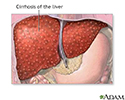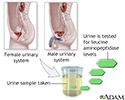Leucine aminopeptidase - urine
Leucine aminopeptidase is a type of protein called an enzyme. It is normally found in liver cells and cells of the small intestine. This test is used to measure how much of this protein appears in your urine.
Your blood can also be checked for this protein.
A 24-hour urine sample is needed.
- On day 1, urinate into the toilet when you get up in the morning.
- Afterward, collect all urine in a special container for the next 24 hours.
- On day 2, urinate into the container when you get up in the morning.
- Cap the container. Keep it in the refrigerator or a cool place during the collection period.
Label the container with your name, the date, the time of completion, and return it as instructed.
For an infant, thoroughly wash the area where urine exits the body.
- Open a urine collection bag (a plastic bag with an adhesive paper on one end).
- For males, place the entire penis in the bag and attach the adhesive to the skin.
- For females, place the bag over the labia.
- Diaper as usual over the secured bag.
This procedure may take more than one try. An active infant can move the bag, so that the urine leaks into the diaper.
Check the infant often and change the bag after the infant has urinated into it.
Drain the urine from the bag into the container given to you by your health care provider. Deliver the sample to the laboratory or your provider as soon as possible.
Your provider will tell you, if needed, to stop taking drugs that may interfere with the test.
How to Prepare for the Test
Your provider may tell you to stop taking any medicines that could affect the test. Drugs that can affect the results of this test include estrogen and progesterone. Never stop taking any medicine without first talking to your provider.
How the Test will Feel
The test involves only normal urination. There is no discomfort.
Why the Test is Performed
You may need this test to see if there is liver damage. It may also be done to check for certain tumors.
This test is only rarely done. Other tests such as gamma glutamyl transpeptidase are more accurate and readily available.
Normal Results
Normal values range from 2 to 18 units per 24 hours.
Normal value ranges may vary slightly among different laboratories. Talk to your provider about the meaning of your specific test results.
The examples above show the common measurements for results of these tests. Some laboratories use different measurements or may test different specimens.
What Abnormal Results Mean
Increased levels of leucine aminopeptidase can be seen in several conditions:
- Cholestasis
- Cirrhosis
- Hepatitis
- Liver cancer
- Liver ischemia (reduced blood flow to the liver)
- Liver necrosis (death of liver tissue)
- Liver tumor
- Pregnancy (late stage)
Risks
There is no risk to a urine collection.
References
Daniels L, Khalili M, Goldstein E, Bluth MH, Bowne WB, Pincus MR. Evaluation of liver function. In: McPherson RA, Pincus MR, eds. Henry's Clinical Diagnosis and Management by Laboratory Methods. 24th ed. Philadelphia, PA: Elsevier; 2022:chap 22.
Korenblat KM, Berk PD. Approach to the patient with jaundice or abnormal liver tests. In: Goldman L, Schafer AI, eds. Goldman-Cecil Medicine. 26th ed. Philadelphia, PA: Elsevier; 2020:chap 138.
Cirrhosis of the liver - illustration
Cirrhosis of the liver
illustration
Leucine aminopeptidase urine test - illustration
Leucine aminopeptidase urine test
illustration
Review Date: 2/1/2023
Reviewed By: Michael M. Phillips, MD, Emeritus Professor of Medicine, The George Washington University School of Medicine, Washington, DC. Also reviewed by David C. Dugdale, MD, Medical Director, Brenda Conaway, Editorial Director, and the A.D.A.M. Editorial team.









